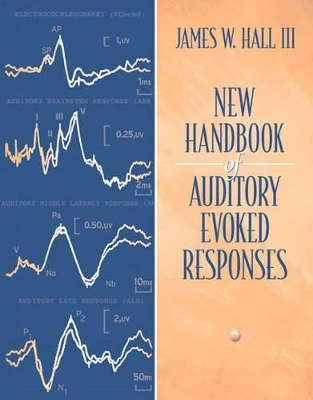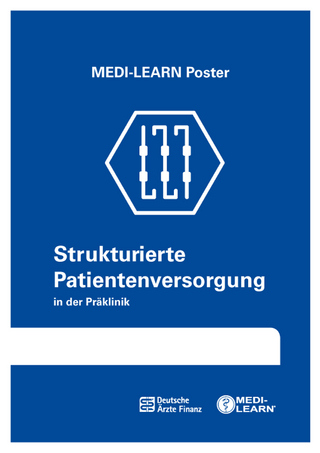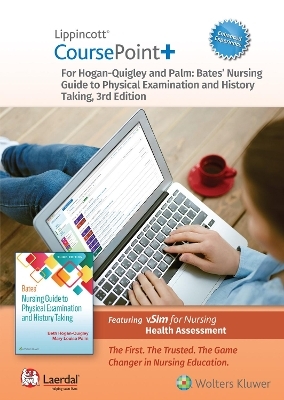
New Handbook for Auditory Evoked Responses
Pearson
978-0-205-36104-5 (ISBN)
- Titel ist leider vergriffen;
keine Neuauflage - Artikel merken
Authored by a clinical audiologist who records auditory evoked responses daily in his clinical practice, this book maintains a consistent writing-style and difficulty level from beginning to end. The content is of direct interest to clinical audiologists and others involved in the clinical measurement of auditory evoked responses. The book includes an extensive review of test principles, protocols, and procedures required for clinical application of auditory evoked responses. The practical coverage of material includes guidelines for trouble-shooting and solving problems commonly encountered in the field.
Principles common to different auditory evoked responses, including anatomy and physiology and general measurement principles (Chs. 1-3), are introduced, allowing readers to learn the material from only this source without having to purchase an additional book to master the basics. At least one chapter is devoted to each major auditory evoked response, beginning with cochlear responses and continuing to the cortical evoked responses, electric evoked responses, and non-auditory responses (Chs. 4-16). Readers are taught to record, analyze and interpret responses for various patient populations (Chs. 4-16). Includes readable and clinically oriented reviews of extensive literature on complex responses, such as the P300 and MMN (Chs. 4-16), making it the only book of its kind to present a balanced coverage of evoked responses recorded from the entire auditory system (cochlea to cortex). The literature on auditory evoked responses in diverse pathologies is reviewed and related to back to clinical practice so that readers do not have to locate additional journal articles (Chs. 4-16). Important concepts, including the effects of measurement parameters and pathologies on auditory evoked responses, are illustrated through hundreds of clear drawings, to help enhance learning (Chs. 4-16).
James W. Hall III, Ph.D. received a Masters degree from Northwestern University and, in 1979, his Ph.D. in audiology from Baylor College of Medicine under the direction of Dr. James Jerger. Since then, he has held clinical and academic audiology positions at the University of Pennsylvania School of Medicine, University of Texas School of Medicine-Houston, and the School of Medicine at Vanderbilt University. Dr. Hall is now Clinical Professor and Chief of Audiology in the Department of Communicative Disorders at the University of Florida in Gainesville. In addition to his administrative duties, he maintains a clinical practice at University of Florida Health Science Center, and serves as a clinical instructor and mentor in the Doctor of Audiology on-site and distance learning programs. Dr. Hall’s main research interests are in the area of auditory neurophysiology, clinical assessment of auditory processing disorders and central auditory nervous system function, newborn hearing screening, and tinnitus & hyperacusis. Dr. Hall lectures internationally on these topics. He is the author of numerous journal articles, monographs, or book chapters, as well as the Handbook of Auditory Evoked Responses and Audiologists’ Desk Reference Volumes I and II, the Handbook of Otoacoustic Emissions and the New Handbook of Auditory Evoked Responses.
Preface
Acknowledgements
I. AUDITORY NEUROPHYSIOLOGY PRINCIPLES.
1. Overview of Auditory Neurophysiology: Past, Present, and Future.
2. Anatomic and Physiologic Principles.
3. Introduction to Auditory Evoked Response Measurement.
II. ELECTROCOCHLEOGRAPHY (ECochG).
4. Measurement, Analysis, and Interpretation
Background
Test protocols, parameters, and procedures
Waveform analysis
Non-pathologic factors influencing ECochG
Trouble-shooting in ECochG recording
5. Clinical Applications and Populations.
Audiologic assessment
Diagnosis of Meniere's disease
Retrocochlear auditory dysfunction
Auditory neuropathy
Intra-operative monitoring
III. AUDITORY BRAINSTEM RESPONSE (ABR) AND AUDITORY STEADY STATE RESPONSE (ASSR).
6. ABR Protocols, Parameters & Procedures.
Background
Basic ABR test protocol
Stimulus parameters
Acquisition parameters
Step-by-step ABR measurement
7. ABR Analysis and Interpretation.
Conventional waveform analysis
Sophisticated waveform analysis
Non-pathologic factors influencing ABR recording
Trouble-shooting in ABR recording
Interpretation of ABR in auditory dysfunction
8. Frequency-Specific ABR and ASSR.
Background
Newborn hearing screening and early identification of hearing loss
Tone burst ABR protocols, parameters and procedures
ASSR protocols, parameters and procedures
Sedation
Case reports
9. ABR: Pediatric Clinical Applications and Populations.
Conductive auditory dysfunction
Sensory auditory dysfunction
Auditory neuropathy and retrocochlear auditory dysfunction
Central nervous system pathologies
Newborn hearing screening
10. ABR: Adult Clinical Applications and Populations.
Sensory auditory dysfunction
Retrocochlear auditory dysfunction
Central nervous system pathologies
Intra-operative monitoring
IV. CORTICAL AUDITORY EVOKED RESPONSES.
11. Auditory Middle Latency Response (AMLR).
Background
Test protocols and procedures
Analysis and interpretation
Clinical applications and populations
12. Auditory Late Response (ALR).
Background
Test protocols and procedures
Analysis and interpretation
Clinical applications and populations
13. P300 Response.
Background
Test protocols and procedures
Analysis and interpretation
Clinical applications and populations
14. Mismatch Negativity (MMN) Response.
Background
Selected cortical auditory responses
Test protocols and procedures
Analysis and interpretation
Clinical applications and populations
v. NON-AUDITORY CLINICAL NEUROPHYSIOLOGY.
15. Electrical and Myogenic Evoked Responses.
Electrically Evoked Auditory Responses
Clinical applications before and after cochlear implants
Electrical compound action potentials (ECAP)
Electrical auditory brainstem response (EABR)
Electrical cortical auditory responses
Vestibular Evoked Myogenic Responses (VEMP)
Historical overview and clinical rationale
Test protocols and procedures
Analysis and interpretation
Clinical applications and populations
Electroneuronography (ENoG)
Historical overview and clinical rationale
Test protocols and procedures
Analysis and interpretation
Clinical applications and populations
APPENDICES
A. Normative Data for Infants and Adults
B. Auditory Electrophysiology Self Test
GLOSSARY.
REFERENCES.
NAME INDEX.
SUBJECT INDEX.
| Erscheint lt. Verlag | 7.11.2006 |
|---|---|
| Sprache | englisch |
| Maße | 216 x 276 mm |
| Gewicht | 1928 g |
| Themenwelt | Medizin / Pharmazie ► Medizinische Fachgebiete ► HNO-Heilkunde |
| Studium ► 2. Studienabschnitt (Klinik) ► Anamnese / Körperliche Untersuchung | |
| ISBN-10 | 0-205-36104-8 / 0205361048 |
| ISBN-13 | 978-0-205-36104-5 / 9780205361045 |
| Zustand | Neuware |
| Informationen gemäß Produktsicherheitsverordnung (GPSR) | |
| Haben Sie eine Frage zum Produkt? |
aus dem Bereich


